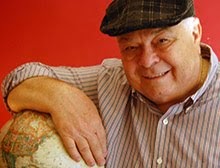 |
| The island of Santorini is one of the most popular destinations in Greece (greecetours.com) |
Imerovigli,
Santorini — Nearly every traveler who visits Santorini in the Greek Isles has an
epiphany. It happens when the island's white snow-capped peaks lining the crest
of the mountain morph into white, sugar-cubed dwellings.
Most people arrive at
Santorini from the sea, sailing into a backwards "C" shaped volcanic
caldera. The eruption, one of the largest volcanic events in recorded history,
is dated to the middle of the second millennium BCE, created the largest and
southernmost of the Cyclades Islands in the Aegean Sea .
| Rooms with a view (iconicsantorini.com) |
Some believe it was
this eruption that gave rise to many of the legends in Greek mythology,
including the Lost City of Atlantis.
Today, a combination
of breathtaking scenery and idyllic accommodations blend with world class
shopping and historical exploration to make Santorini one of the most beguiling
destinations in Greece
If you happen to be among the thousands of visitors who
discover the charms of Santorini either now or in the future, here are some
suggestions that to enhance your adventure.
 |
| A quad ATV is one of the best ways to see the island (santorinibikerentals.com) |
Rent a Quad Bike: A quad bike is an all-terrain vehicle (ATV) with four wheels that
operates on low pressure tires with a seat that is straddled by the driver. As
the name implies, it is designed for a variety of surfaces which makes it ideal
for sightseeing on Santorini's sloping geography.
The gas
powered motor allows you to maneuver the steepest hill while the compact size
provides access to places that otherwise could only be viewed on foot. Best of
all, rates begin at about $35 per day which makes for plenty of independent
exploration without breaking the bank.
 |
| Akitori is an active dig (wikipedia) |
Visit a Working
Archaeological Dig:
Remember those old movies about
archaeological digs in Egypt
Perhaps
it was the black and white format or the scratchy soundtrack that made those
pictures come alive with ominous
sensations of ancient history that modern films, for all their technology,
cannot duplicate.
Whatever
it was, if you have ever been intrigued by the idea of watching or
participating in a real archaeological dig, you can do it on Santorini at
ancient Akritori. Here you can observe scientists unearthing shard by shard and
cobblestone by cobblestone among the ruins of a city that existed in the 17th
century -- BC that is.
Shhh.
Mummy's the word.
 |
| Greek mythology abounds on Santorini (wikipedia) |
Marvel at Ancient Treasures: One
of the difficult things to adjust to when visiting Greece
The Museum of Prehistoric Thera
 |
| Assyrtiko is the distinctive local wine (iconicsantorini.com) |
Sip an Assyrtiko: There
are wine tastings and then there are vino tastings and Santorini's distinctive
Assyrtiko wine puts this adventure into the second category.
Guests
can do a 4-hour vineyard tour complete with a sommelier (and driver) where you
sample a glass or two of Santorini's unique native wine.
Or if you
prefer, when you've competed a day at the dig or a morning at the museum or
just want to take a break from your quad bike excursion you can do that as well
at a local taverna.
Either
way, be sure to savor the most popular wine on the island before you depart.
 |
| Famous Red Beach really is red (wikipedia) |
Cool off on Red Beach : Cancun has its powdery talcum powered white
sand beaches. In Bermuda some beaches are
pink. There are even black beaches in other parts of the world where volcanoes
have erupted in the past. But Santorini has the distinction of having a red
beach thanks to the metallic acidity from the eruption.
 |
| Pass the time cruising on a catamaran in the caldera (santorinicatamaran.com) |
Cruise the Caldera: Sailing into Santorini's caldera is
one thing, but to experience it aboard a 74-foot catamaran is a different
experience entirely. If you take this adventure, play a little game with
yourself and see if you can figure out when the white houses begin to look like
snow.
 |
| Sunrise on Santorini as seen from Iconic Santorini (iconicsantorini.com) |
The
concierges at Icnonic Santorini, an extraordinary 19-room boutique hotel that
is literally carved into the island's white vaulted caves, can arrange for any
or all of these marvelous adventures. And, as the description implies, Iconic
Santorini adds yet another dimension to this unique travel experience all by
itself.
Oh, and
there is one other treasure not to be missed during your stay:
Pistachios: They're
the best in the world. 'Nuff said.































